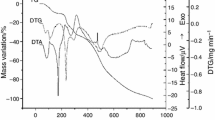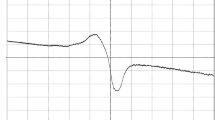Abstract
Co(II), and Mn(II) complexes using 2,2′-(2-((carboxymethyl)(2-(2-hydroxyethoxy)-2-oxoethyl)amino)ethylazanediyl)diacetato (SCHOEA), derivative of disodium salt of EDTA were synthesized by three stages and characterized by spectroscopic (UV–Visible, FTIR, EPR, 1H NMR) techniques, magnetic susceptibility measurements and thermal studies (TA). Electronic and magnetic susceptibility measurements indicated low-spin octahedral complexes. The FTIR spectra supported the coordination mode of the ligand as hexadentate with the metal ions. Molar conductivity supported the non-electrolytic nature of the complexes. The EPR spectra confirmed the distorted octahedral geometry of the complexes based on the computation of Hamiltonian parameters and the degree of covalency. In vitro antimicrobial activities of the ligand and metal complexes against three bacterial (Enterobacteraerogenes, Micrococcus luteus, Shigellaflexineria) and two fungal species (Candida albicans, Aspergillusflavus) were performed by disc diffusion method which revealed that the complexes are more potent bactericides and fungicides than the ligand.




Similar content being viewed by others
References
Chandra S, Kumar U. Spectral and magnetic studies on manganese(II), cobalt(II) and nickel(II) complexes with Schiff bases. Spectrochim Acta. 2005;61:219–27.
Pravin N, Devaraji V, Raman N. Targeting protein kinase and DNA molecules by diimine-phthalate complexes in antiproliferative activity. Int J Biol Macromol. 2015;79:837–55.
Scanlon KJ, Kashani MS, Miyachi H, Sowers LC, Rossi J. Molecular basis of cisplatin resistance in human carcinomas: model system and patients. Anticancer Res. 1989;9:1310–2.
Perez RP, Hamilton TC, Ozols RF, Young RC. Mechanisms and modulation of resistance to chemotherapy in ovarian cancer. Cancer. 1993;71:1571–80.
Wang D, Lippard S. Cellular processing of platinum anticancer drug. J Nat Rev Drug Discov. 2005;4:307–20.
Anitha C, Sheela CD, Tharmaraj P, Sumathi S. Spectroscopic studies and biological evaluation of some transition metal complexes of azo Schiff-base ligand derived from (1-phenyl-2,3-dimethyl-4-aminopyrazol-5-one) and 5-((4-chlorophenyl)diazenyl)-2-hydroxybenzaldehyde. Spectrochim Acta A. 2012;96:493–500.
Gaber M, El-Hefnawy GB, El-Borai MA, Mohamed NF. Synthesis, spectral and thermal studies of Mn(II), Co(II), Ni(II), Cu(II) and Zn(II) complex dyes based on hydroxyquinoline moiety. J Therm Anal Calorim. 2012;109:1397–405.
Patil SA, Unki SN, Badami PS. Synthesis, characterization, biological and thermal behavior of Co(II), Ni(II) and Cu(II) complexes with Schiff bases having coumarin moieties. J Therm Anal Calorim. 2013;111:1281–9.
Avsar G, Altinel H, Yilmaz MK, Guzel B. Synthesis, characterization and thermal decomposition of fluorinated salicylaldehyde Schiff base derivatives (salen) and their complexes with copper(II). J Therm Anal Calorim. 2010;101:199–203.
Samsonowicz M, Regulska E. Spectroscopic study of molecular structure, antioxidant and biological effects of metal hydroxyflavonol complexes. Spectrochim Acta Part A: Mol Biomol Spectrosc. 2017;173:757–71.
Badea M, CaluI ChifiriucMC, Bleotu C, Marin A, et al. Thermal behaviour of some novel antimicrobials based on complexes with a Schiff base bearing 1,2,4-triazole pharmacophore. J Therm Anal Calorim. 2014;118:1145–57.
Zayed EM, Zayed MA, Hindy AMM. Thermal and spectroscopic investigation of novel Schiff base, its metal complexes, and their biological activities. J Therm Anal Calorim. 2014;116:391–400.
Sekerci M, Yakuphanogulu F. Thermal analysis study of some transition metal complexes by TG and DSC methods. J Therm Anal Calorim. 2004;75:189–95.
Magri AL, Magri AD, Balestrieri F, Cardarelli E, Ascenzo GD, Chiacchierini E. Thermal properties and spectroscopic characteristics of the complexes of pyrazine-2-carboxylic acid with divalent metal ions. Thermochim Acta. 1980;38(2):225–33.
Raman N, Sobha S, Thamaraichelvan A. A novel bioactive tyramine derived Schiff base and its transition metal complexes as selective DNA binding agents. Spectrochim Acta A. 2011;78:888–98.
Poddel’sky AI, Cherkasov VK, Abakumov GA. Transition metal complexes with bulky 4,6-di-tert-butyl-N-aryl(alkyl)-o-iminobenzoquinonato ligands: structure, EPR and magnetism. Coord Chem Rev. 2009;253:291–324.
Gurumoorthy P, Dharmasivam M, Durai P, Chinnasamy A, Rahiman AK. Magneto-structural correlation, antioxidant, DNA interaction and growth activities of new chloro-bridged phenolate complexes. RSC Adv. 2014;4:42855–72.
Karthikeyan MS, Parsad DJ, Poojary B, Bhat KS, Holla BS, Kumari NS. Synthesis and biological activity of Schiff and Mannich bases bearing 2,4-dichloro-5-fluorophenyl moiety. Bioorg Med Chem. 2006;14:7482–9.
Panneerselvam P, Nair RR, Vijayalakshmi G, Subramanian EH, Sridhar SK. Synthesis of Schiff bases of 4-(4-aminophenyl)-morpholine as potential antimicrobial agents. Eur J Med Chem. 2005;40:225–9.
Singh K, Barwa MS, Tyagi P. Synthesis, characterization and biological studies of Co(II), Ni(II), Cu(II) and Zn(II) complexes with bidentate Schiff bases derived by heterocyclic ketone. Eur J Med Chem. 2006;41:147–53.
West DX, Liberta AE, Padhye SB, Chikate RC, Sonawane PB, Kumbhar AS, Yerande RG. Thiosemicarbazone complexes of copper(II): structural and biological studies. Coord Chem Rev. 1993;123:49–71.
Zhang T, Wei H, Yang XH, Xia B, et al. Influence of the selective EDTA derivative phenyldiaminetetraacetic acid on the speciation and extraction of heavy metals from a contaminated soil. Chemosphere. 2014;109:1–6.
Santos MA, Gama S, Gano L, Farkas E. Bis (3-hydroxy-4-pyridinone)-EDTA derivative as a potential therapeutic Al-chelating agent. Synthesis, solution studies and biological assays. J Inorg Biochem. 2005;99:1845–52.
Singh P, Aggarwal S, Tiwari AK, Kumar V, Pratap R, et al. Bis (Methylpyridine)-EDTA derivative as a potential ligand for PET imaging: synthesis, complexation, and biological evaluation. Chem Bio Drug Des. 2014;84:704–11.
Huang H, Liu L, Zhang L, Zhao Q, Zhou Y, Yuan S, Tang Z, Liu X. Peroxidase-like activity of ethylene diaminetetraacetic acid and its application for ultrasensitive detection of tumor biomarkers and circular tumor cells. Anal Chem. 2016;89:666–72.
Chatterjee D, Mitra A (2006) Ruthenium polyaminocarboxylate complexes, www.technology.matthey.com. https://doi.org/10.1595/147106705x82874.
Gopalan R, Ramalingam V. Concise coordination chemistry. Copyright, 2001.
Lever ABP. Inorganic electronic spectroscopy. Amesterdam: Elsevier; 1984.
Ramesh R, Maheswaran S. Synthesis, spectra, dioxygen affinity and antifungal activity of Ru(III) Schiff base complexes. J Inorg Biochem. 2003;96(4):457–62.
Mahendiran D, Gurumoorthy P, Gunasekaran K, Kumar RS, Rahiman AK. Structural modeling, in vitro antiproliferative activity, and the effect of substituents on the DNA fastening and scission actions of heteroleptic copper(II) complexes with terpyridines and naproxen. New J Chem. 2015;39:7895–911. https://doi.org/10.1039/C5NJ01059D.
Sandhu GK, Verma SP. Triorganotin(IV) derivatives of five membered heterocyclic 2-carboxylic acids. Polyhedron. 1987;3:587–92.
Singh HL, Singh J. Synthesis, spectral, 3D molecular modeling and antibacterial studies of dibutyltin(IV) Schiff base complexes derived from substituted isatin and amino acids. Nat Sci. 2012;4:170.
Pavia DL, Lampman GM, Kriz GS. Introduction to spectroscopy. 3rd ed. Washington: W. B. Saunders Co.; 2001.
Nakamoto K. Infrared and raman spectra of inorganic and coordination compounds. 4th ed. New York: Wiley; 1986.
Raman N, Pravin N. DNA fastening and ripping actions of novel Knoevenagel condensed dicarboxylic acid complexes in antitumor journey. Eur J Med Chem. 2014;80:57–70.
Ray RK, Kauffman GB. EPR spectra and covalency of bis (amidinourea/O-alkyl-1-amidinourea) copper(II) complexes part II. Properties of the CuN4 2−chromophore. Inorg Chim Acta. 1990;173(2):207–14.
Anjaneyulu Y, Rao RP. Preparation, characterization and antimicrobial activity studies on some ternary complexes of Cu (II) with acetylacetone and various salicylic acids. Synth React Inorg Met-Org Chem. 1986;16:257–272.
Funding
The funding was provided by LCTOI Project (Grant No. 2LCTOI14CHM002).
Author information
Authors and Affiliations
Corresponding author
Electronic supplementary material
Below is the link to the electronic supplementary material.
Rights and permissions
About this article
Cite this article
Jeya Rajendran, A., Dhawa, S., Jeya Jothi, G. et al. Thermal, spectroscopic and in vitro antimicrobial analysis of 2, 2′-(2-((carboxymethyl)(2-(2-hydroxyethoxy)-2-oxoethyl)amino)ethylazanediyl)diacetatocobalt(II)/manganese(II) hydrate. J Therm Anal Calorim 134, 1965–1973 (2018). https://doi.org/10.1007/s10973-018-7729-2
Received:
Accepted:
Published:
Issue Date:
DOI: https://doi.org/10.1007/s10973-018-7729-2




